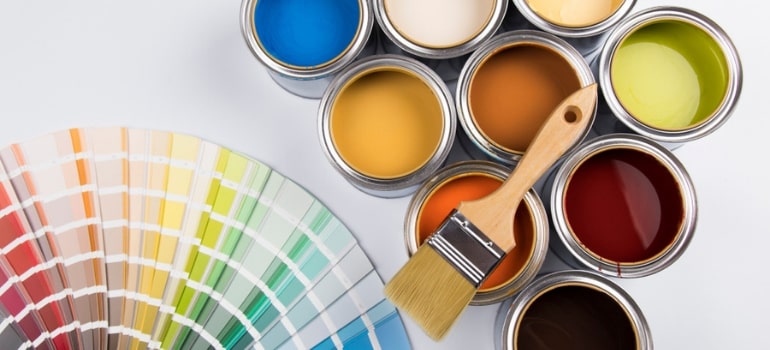

Paints are a fascinating world filled with colors and finishes, but they’re also a bit confusing. There are a lot of paint types to choose from for every project, and they all appear similar. Let’s dive deeper into what are enamel paints?
If you like doing DIY projects and fixing up small items around the house, you’d no doubt be familiar with enamel paints. These paints are known for their brilliant gloss and ease of application. Enamel paints are versatile and can be applied to wood, metal, concrete, plastic, and even glass. Here’s everything you need to know about enamel paints, from what it is and what it isn’t, to where and how it is used.
What is Enamel Paint?
Enamel paint is a type of paint that dries to a hard and glossy finish when exposed to air. Enamel paints are typically used to provide a smooth and shiny finish to surfaces, and sometimes, to create protective barriers on materials. While these paints were mostly oil-based, water-based enamel paint is now available as well.
Enamel paint gets its name from the glossy finish it creates that resembles enamelled pottery. The process of enameling pottery, however, is significantly different and has no connection with enamel paints. While enamel paints are also known as “hard-surfaced” paints, the finish is actually much softer than porcelain enamel.
Origins and History
In the 1800s, porcelain was well-known for its toughness, durability, and sanitary properties. However, it was prohibitively expensive and well out of the reach of the common man. At the time, an affordable paint was introduced that claimed to apply the properties of porcelain on any surface. Since most people had heard of porcelain, it was much easier to market the paint under the name of “enamel paint”. While it was still more expensive than regular paint, the inclusion of the word “enamel” had a big impact on its sales and application.

Advantages of Enamel Paints
- Durability
Enamel paint forms a hard, impermeable shell when dry, and is resistant to moisture and mildew. A coating of enamel paint lasts several years and can be a great way to protect furniture and surfaces outdoors. The paint is a waterproof, long term solution for painting surfaces that are exposed to wind, water, and snow.
- Ease of cleaning
Enamel painted surfaces are glossy and easy to keep clean. You can simply wipe these down with a piece of cloth to remove dust and dirt. Furniture and walls with glossy enamel paint are great in areas that tend to accumulate dirt or get stained easily.
- Even Application
Enamel paint is very easy to apply. Once the surface to be painted has been prepared suitably, enamel paint spreads quickly and easily. It is even available in spray cans for direct application without the need for a brush.
Disadvantages of Enamel Paints
- Slow Drying
Enamel paint is quite slow to dry. Depending on the type (oil or water-based), the paint will either dry from the inside out, or inwards from the outermost layer. Oil-based enamel paint can take anywhere from 8-24 hours to dry, while water-based enamel paint can take longer. Additionally, while the paint is drying, it is important to maintain constant temperature and humidity levels to ensure a proper finish.
- Hard to Handle
Enamel paints often have strong, pungent odors. They also contain substances that make them toxic, requiring them to be handled with care and caution. Such paints also require the use of thinners such as white spirit or mineral spirit. While more common thinners such as acetone or turpentine can be used, their effectiveness can vary greatly. Oil-based enamel paints are also notoriously hard to clean off without damaging the surface underneath, so managing paint run-off is essential while using them.
Types of Enamel Paints
Oil and water-based enamels are the two distinct types of enamel paints you need to know about. Take a look at the differences between these to choose the best paint for your project.
Oil-based enamel paints
- Suitable for outdoor use.
- Lasts longer and can withstand wear and tear better.
- Contains Volatile Organic Compounds (VOC) and can be flammable.
- Takes 6-8 hours to dry after painting.
- Creates a smooth finish with high gloss.
- Needs turpentine or other solvents to be removed.
- High gloss surfaces with oil-based enamels are washable.
Water-based enamels
- Suited for indoor and outdoor use.
- Large range of colors to choose from.
- Takes 1-2 hours to dry after painting.
- Can withstand UV exposure better.
- Reduced gloss levels compared to oil-based enamels.
- Non-flammable and has less odor.
- Better for the environment.
Enamel Paint Uses
Enamel paints are versatile in their application, and can be used for small DIY projects and large exterior painting alike. Enamels are most preferred for use in areas where high gloss and ease of cleaning are required.
- Outdoor Furniture

Enamel is the best choice for painting outdoor furniture, be it wood or metal. The paint forms a hard coating that keeps chairs and tables safe from the extremities of weather. Enamel paints also give a new lease of life to faded outdoor furniture with bright colors and UV protection.
- Cabinets
Kitchen cabinets endure heavy usage along with an increased risk of stains and grime. An enamel paint coating makes sense in such areas, as the paint lasts through repeated usage. Glossy enamel coating can be cleaned easily, making them a good choice for kitchen cabinets. All you need to do is simply wipe them down for the cabinets to look as good as new.
- Appliances
Enamel paints are useful for touching up minor chips and scratches on appliances. The shiny finish and smooth application of enamels make them well suited to this purpose. Heat-resistant enamel paints are the best choice for such applications.
- Floors
Spruce up your porch with a coat of enamel paint. The high gloss paint is favored for painting porches and garage floors to keep them protected for years and to make cleanup easy. Enamel paint adheres well to wood and concrete, making it perfect for protecting outdoor flooring.
- Handrails

Keep handrails free from dust and dirt with a coat of high gloss enamel paints. Enamels are excellent for painting handrails in high traffic areas, as they make it easy to clean and avoid contamination.
- Trims
Make your door and window casings and baseboard trims last longer with a few coats of enamel paint. The hard shell protects the trims from damage and increases their durability. The large variety of enamel paints available make matching the paints with the rest of the design easy.
To learn more about the right paint for your project, check out our Low Voc Paint.
Sign In
Register
Reset Password
Membership
An active membership is required for this action, please click on the button below to view the available plans.
